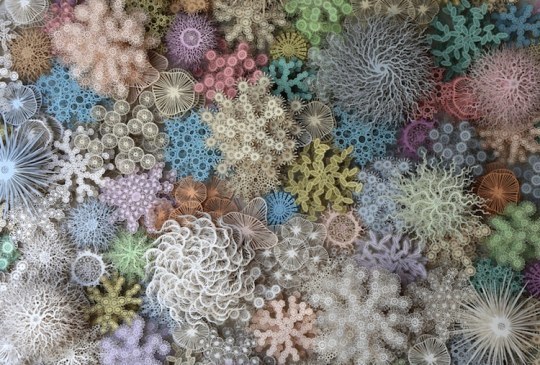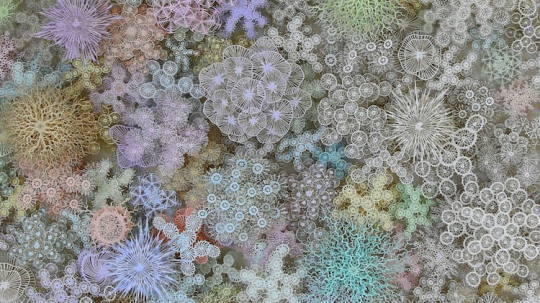Chris Howard's Blog, page 62
June 14, 2018
June 10, 2018
The pier-baseplate-on-the-tripod project is complete, and...
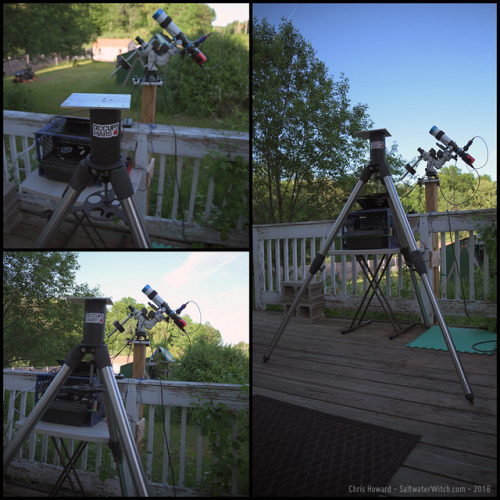
The pier-baseplate-on-the-tripod project is complete, and tonight’s slogan is “Summer: portable, Winter: pier” (a slogan typically means “a short and striking or memorable phrase used in advertising”, but you can probably tell I’m using it in the historic “Scottish war cry” sense here). The skies look clear this evening, and I’ll still be using the William Optics ZS61 on the “pier”, which stands just off the back deck. I set this up last fall so that I could do my astro stuff through the winter, and not have to lug a lot of heavy, expensive equipment through snow and ice, and all winter long I’ve been carrying my EQ mount, scope, and counterweights five steps out the back door to set it down and bolt it to the aluminum baseplate. It was easy and I could ready to go in a few minutes. Well, it’s almost time to move the whole operation further from the house. See the shed in the background there? This time of year, and through the autumn, I usually work off the tripod out there, about 120 feet/36m from the house. This gives me a lot more sky east of the meridian–a lot more than the view from the deck, which has a tree obstructing things to about 45° to the northeast, and I can only reach 10-15° past the meridian to the south. So, it’s almost time. I’m ready with my portable tripod (with the pier plate). I’m ready to shout that war cry to summer night sky: “SUMMER PORTABLE!”
The Sadr Region is an area of ionized hydrogen including the...
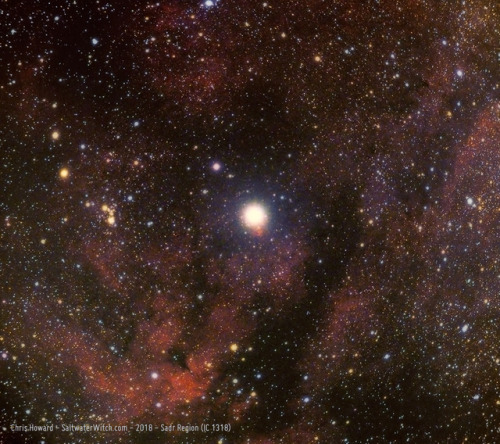
The Sadr Region is an area of ionized hydrogen including the diffuse nebula (IC 1318) that surrounds the central star in the constellation Cygnus, Sadr (gamma Cygni). ZWO ASI071MC cooled CMOS camera at -10°C, iOptron CEM25P EQ mount, William Optics ZenithStar 61 f/5.9, 12 x 120 sec. sub exposures + 10 dark frames, stacked in DSS. Location: Stratham, New Hampshire, US.
June 9, 2018
I spent a few hours last night dialing in the Orion...

I spent a few hours last night dialing in the Orion “TOAG” or Thin Off-Axis Guider, which I bought a couple years ago, but have never been able to get working properly. I’ve tried seven or eight times, added it to my imaging train a couple times a year, attempting to get things working without success. Well, I went at it again last night, and you know what? It came together. I still have some weirdness to tinker with–to work out, but for the first time I wasn’t guiding with a separate scope. I was guiding at the same focal length as the ZS61 using a pick-off prism that directs a portion of the field of view up into the guide camera. Here’s the setup I used last night to dial-in the distance between the primary camera and guide camera, and then bring everything into focus. I ended up with some pretty cool shots, but my main purpose was to get Off-Axis Guiding (OAG) adjusted and working–and that was with me slewing around the sky to clear areas between banks of clouds to find some halfway interesting targets. In this setup I’m using my trusty ZWO ASI120MM-S for guiding, and the ZWO ASI071MC cooled color camera for the primary. The goal here is to be able to guide (track the motion of the earth against the star field to a very fine degree, and make small incremental adjustments to the EQ mount) so that I can take long exposures without worrying about the external guidescope issues I know all of you care deeply about, like field rotation and differential motion between a guide scope and imaging telescope. I have been able to take 20 minute exposures with a guidescape and camera, but the stars are not as sharp as I would like–think pressing down the button of your camera and holding the shutter open for 20 or 30 minutes and have everything in the field of view remain in sharp focus. That’s essentially what the guiding system accomplishes, taking continuous images of the stars and feeding them to some pretty sophisticated software that controls the motion of the equatorial mount (that’s the white z-shaped device with the black boxes on which the telescope is fastened and balanced).
How about a little Voldemort with your Astronomy? Here’s...
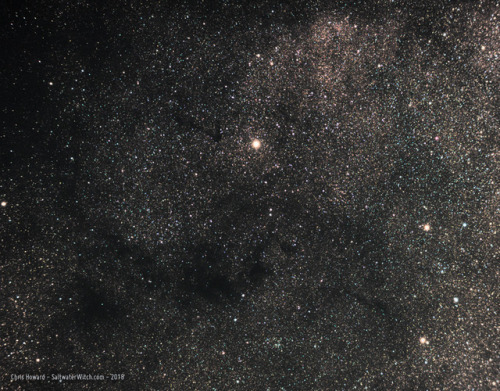
How about a little Voldemort with your Astronomy? Here’s Barnard 104, the Fish Hook Nebula, just left of the star beta Scuti in the constellation Scutum–along with several other absorption nebulae in the Barnard Catalogue, 113, 111, 110, 107, and B106. These are the dark cloudy regions across the middle, which stand out against the glow of a billion stars in this area of the Milky Way Galaxy. (Okay, I’m being a bit deceptive with the drama there. It’s probably more like 5 or 10 billion). Oh, and let’s not forget NGC 6704, the open star cluster toward the bottom in the center. A note on the “Barnard Catalogue”, which is what I’ve always called it: I just found out the official name for it is the very Harry Potter sounding, Barnard Catalogue of Dark Markings in the Sky. Eat it, Death Eaters! The star gazing geeks got here first! (ZWO ASI071MC cooled CMOS camera at -10°C, iOptron CEM25P EQ mount, William Optics ZenithStar 61 f/5.9, 12 x120 sec. sub exposures, stacked in DSS. Location: Stratham, New Hampshire, US. Bortle 4).
June 8, 2018
discworldtour:
“You’ll be Death, then?” said Vimes, after a while. AH, MISTER VIMES, ASTUTE AS...
“You’ll be Death, then?” said Vimes, after a while.
AH, MISTER VIMES, ASTUTE AS EVER. GOT IT IN ONE, said Death, shutting the book on his finger to keep the place.
“I’ve seen you before.”
I HAVE WALKED WITH YOU MANY TIMES, MISTER VIMES.
“And this is it, is it?”
HAS IT NEVER STRUCK YOU THAT THE CONCEPT OF A WRITTEN NARRATIVE IS SOMEWHAT STRANGE? said Death.
Vimes could tell when people were trying to avoid something they really didn’t want to say, and it was happening here.
“Is it?” he insisted. “Is this it? This time I die?”
COULD BE.
“Could be? What sort of answer is that?” said Vimes.
A VERY ACCURATE ONE. YOU SEE, YOU ARE HAVING A NEAR-DEATH EXPERIENCE, WHICH INESCAPABLY MEANS THAT I MUST HAVE A NEAR-VIMES EXPERIENCE. DON’T MIND ME. CARRY ON WITH WHATEVER YOU WERE DOING. I HAVE A BOOK.– on near-Vimes experiences |
Terry Pratchett, Thud!
June 6, 2018
June 5, 2018
Cover art commissions are open
Cover art commissions are open again for science fiction and fantasy genres. If you’re looking for cover art, please read through the details and review the examples on my Lykeion Studio page: http://saltwaterwitch.com/lykeion. I have updated the terms and conditions, and dropped the pricing a bit.
June 3, 2018
The Crescent Nebula (NGC 6888) with two channels, hydrogen-alpha...
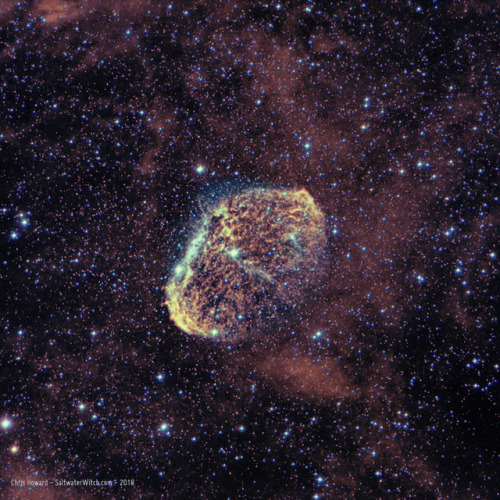
The Crescent Nebula (NGC 6888) with two channels, hydrogen-alpha and oxygen-three. 4 x 1200 second exposures for the Ha (mostly red channel), and 10 x 600 second exp. for the OIII (mostly blue channel). I didn’t get nearly enough of the blue halo around the Crescent as I would have liked. I’ll probably need to go to 20-minute exposures in OIII next time–or more 10 minute ones. http://SaltwaterWitch.com
Mars and the Moon rising. I shot this one around 4:30am EST with...

Mars and the Moon rising. I shot this one around 4:30am EST with the Nikon D750 + 70-300mm f/4.5-5.6. I will post the Crescent Nebula two-channel images later–still have some processing to do.





